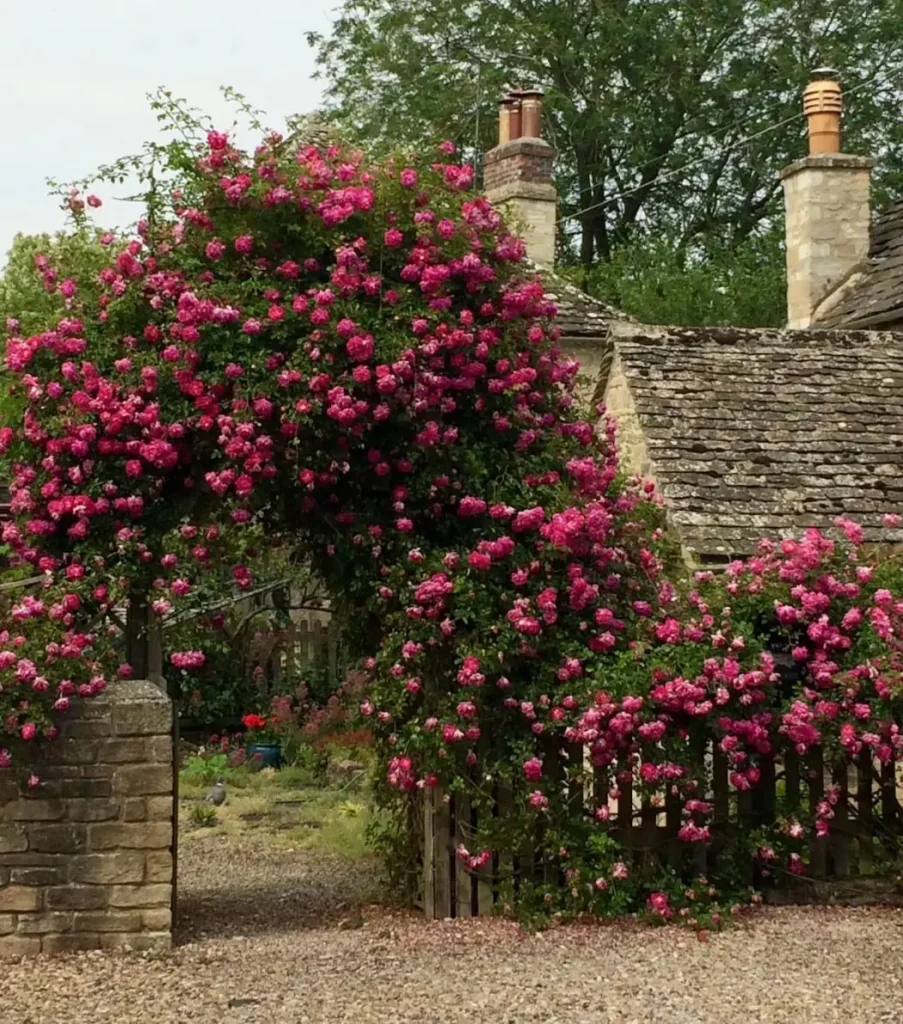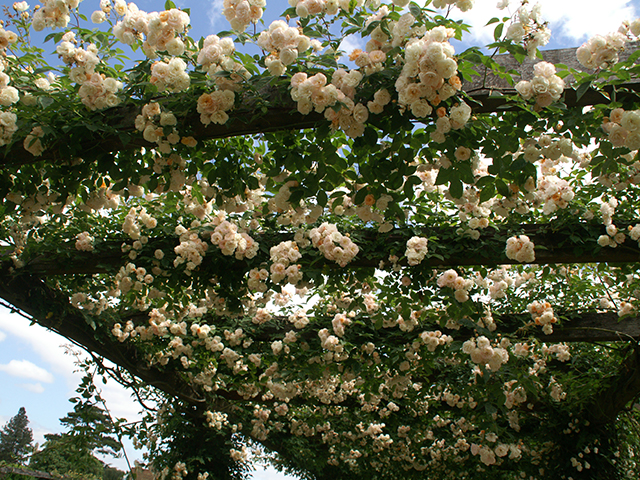For decades, rambling roses have quietly faded from American gardens. Once a staple of cottage landscapes and public parks, these vigorous, once-blooming beauties have been largely forgotten in favor of smaller, modern repeat bloomers. But a new movement is taking root to change that — the Save the Ramblers Initiative.
The Save the Ramblers Initiative is a national campaign led by the American Rose Society to preserve, promote, and reintroduce rambling roses — an often overlooked but historically significant class of roses — into American gardens. With the goal of getting rare varieties from the late Anne Belovich’s private collection into public and private spaces, the initiative also includes educational outreach and partnerships with nurseries to make these special roses more accessible to today’s gardeners.
What Are Ramblers?
Rambling roses, often simply called ramblers, are a class of large, flexible climbing roses that typically bloom once a year in a stunning flush. Unlike traditional climbers, ramblers send out long, pliable canes that can be trained over arbors, fences, and pergolas with minimal pruning. They often bloom in clusters, creating a waterfall effect of fragrant, old-fashioned charm.
While they may not flower all season, their spring display is unmatched. With time-tested varieties like ‘Albertine,’ ‘American Pillar,’ and ‘Veilchenblau,’ these roses bring heritage, fragrance, and romance to the garden in a way that few modern plants can match.

A Look Back: Ramblers in Garden History
In the early 20th century, rambling roses were a fixture in American and European landscapes. They were used to soften the lines of buildings, fill large vertical spaces, and create floral drama on a scale that few other plants could achieve. Estates and public parks often featured massive displays of ramblers cascading over pergolas and stone walls. Their abundant blooms and vigorous growth made them a favorite of garden designers and homeowners alike.
Ramblers, like many roses, also carry deep sentimental and historic value. Some are tied to specific breeders, public gardens, or moments in time. Varieties are named after cherished family members, grand estates, or even literary figures. In this way, they serve not only as ornamental plants but also as living heirlooms — rooted in memory, place, and passion. Rosarians like Anne Belovich devoted decades to collecting and preserving these legacy varieties, understanding that their beauty comes with stories worth telling and saving.
Why Save the Ramblers?
In the U.S., rambling roses have fallen out of favor over the past 50 years. Misunderstood as high-maintenance or impractical, they have all but vanished from mainstream nurseries and garden centers. But the rest of the world never gave up on them. In Europe, ramblers still grace garden walls and historic estates.
The Save the Ramblers Initiative, led by the American Rose Society, aims to bring awareness, education, and access back to this neglected class of roses. Through the efforts of rosarians, garden clubs, and partner nurseries, rare varieties from the late Anne Belovich’s personal collection are now being reintroduced to the public.
Heirloom Roses Joins the Effort
In collaboration with ARS, Heirloom Roses has released the first three ramblers from Anne Belovich’s collection to the public. Each sale contributes directly to the Save the Ramblers Initiative and supports the continued work of preserving these rare roses.
The three newly available varieties are:
- ‘Casimir Moullé’ – A French rambler introduced in 1910 with raspberry-pink blooms and a paler reverse. This vigorous climber can grow up to 20 feet, perfect for arbors or growing into trees. It offers a spectacular early summer flush followed by scattered reblooms.
- ‘Lady Gay’ – Introduced in 1905, this fast-growing rambler bears masses of pink blooms, each with up to 25 petals. It can reach heights of 20 feet and offers a strong spring fragrance with occasional reblooms. Its glossy foliage adds ornamental value year-round.
- ‘Gardenia’ – A Hybrid Wichurana with creamy yellow to white 3-inch blooms and a crisp apple scent. ‘Gardenia’ produces a breathtaking spring display and may rebloom sporadically. Glossy dark foliage and strong canes make it a standout in any garden.

Those who grow these varieties are encouraged to register their plants with ARS to contribute to the national preservation effort.
How You Can Help
Columbus Rose Club is encouraging our members and the broader gardening community to support the Save the Ramblers effort. Here’s how:
- Learn about the value and beauty of rambling roses. Visit rose.org/ramblers for resources and stories.
- Plant a rambler in your own garden. Heirloom Roses has just released three rare varieties with proceeds benefiting the initiative.
- Register your rambler with ARS if you purchase one. This helps track the preservation effort.
- Share your experience with us. Whether you’re planting one for the first time or rediscovering an old favorite, your story can inspire others.
Let’s bring these timeless roses back into the spotlight. It’s time to save the ramblers.
